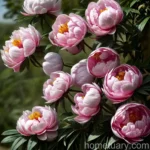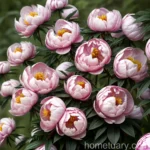Plant Scientist’s Guide to Paeonia Tenuifolia ‘Flore-Plena’ – The Majestic Peony
Peonies, with their striking blooms and robust structure, are a favorite among gardeners and horticultural enthusiasts. Their rich history, coupled with a stunning array of colors and forms, make them a prized addition to any garden. Among the many wonderful peony varieties, Paeonia tenuifolia ‘Flore-Plena’ stands out for its exceptional beauty and unique characteristics. In this comprehensive guide, we will delve into the world of Paeonia tenuifolia ‘Flore-Plena’, exploring its cultural significance, growth requirements, maintenance, and much more.
What is Paeonia Tenuifolia ‘Flore-Plena’?
Paeonia tenuifolia ‘Flore-Plena’ is a captivating herbaceous perennial known for its double flowers and finely dissected foliage. Native to the Caucasus region, this stunning peony variety is a member of the Paeoniaceae family, and it has garnered widespread admiration for its ornamental value.
Amidst the plethora of peony cultivars, Paeonia tenuifolia ‘Flore-Plena’ distinguishes itself with its deeply cut fern-like leaves and captivating double scarlet-red flowers, which bloom in late spring to early summer, adding a splash of vibrant color to the landscape.
Key Takeaways – Paeonia Tenuifolia ‘Flore-Plena’
Before we delve into the specifics of growing and caring for Paeonia tenuifolia ‘Flore-Plena’, here are the key takeaways that we will cover in this guide:
- Cultural significance and uses of Paeonia tenuifolia ‘Flore-Plena’.
- Water requirements for optimal growth.
- Sunlight preferences and its impact on the plant’s health.
- Fertilization needs for promoting vigorous growth.
- Soil requirements and soil management practices.
- Pruning techniques for maintaining the plant’s shape and health.
- Propagation methods for expanding your peony collection.
- Growing Paeonia tenuifolia ‘Flore-Plena’ in containers.
- Common diseases affecting peonies and their diagnosis.
- Identification and management of common pests.
- Insights and tips from a botanist for successful peony cultivation.
- Fun facts and intriguing aspects related to Paeonia tenuifolia ‘Flore-Plena’.
- Links to external resources for further exploration.
Now, let’s embark on a captivating journey into the world of Paeonia tenuifolia ‘Flore-Plena’, uncovering the secrets of cultivating and cherishing this exquisite peony variety.
Culture
Uses
Paeonia tenuifolia ‘Flore-Plena’ holds significant cultural and ornamental value, whether it’s in garden landscapes, floral arrangements, or as a focal point in horticultural displays. The lush, frilly blooms and the finely-cut foliage make it a delight to behold, and in floral arrangements, it adds a touch of elegance and sophistication. In garden landscapes, it serves as a show-stopping specimen, drawing attention with its striking appearance.
Growing Requirements
Water
Proper watering is crucial for the healthy growth and blooming of Paeonia tenuifolia ‘Flore-Plena’. While it is essential to ensure an adequate water supply to the plant, it is equally important to prevent waterlogging, which can lead to root rot and other issues. As a general guideline, aim to water the peony deeply when the soil begins to dry out, ensuring that the water reaches the root zone effectively. During hot and dry spells, regular watering is essential to maintain the plant’s vigor and floral display.
Sunlight
Paeonia tenuifolia ‘Flore-Plena’ thrives in well-lit locations with ample sunlight. To ensure robust growth and prolific flowering, provide it with at least 6 to 8 hours of direct sunlight daily. However, in regions with scorching afternoon sun, some light afternoon shade can be beneficial, particularly to shield the delicate blooms during the hottest parts of the day.
Fertilizer
Feeding Paeonia tenuifolia ‘Flore-Plena’ with a balanced fertilizer can greatly enhance its growth and flowering performance. In early spring, before the new growth emerges, apply a slow-release, balanced fertilizer that is specifically formulated for flowering perennials. Additionally, a light application of organic compost around the base of the plant can further enrich the soil and support the peony’s nutritional needs.
Soil
Well-draining, nutrient-rich soil is essential for the optimal growth of Paeonia tenuifolia ‘Flore-Plena’. Ideally, the soil should be loamy, with a slightly acidic to neutral pH. Prior to planting, amending the soil with organic matter such as compost or well-rotted manure can improve its structure and fertility, providing an ideal environment for the peony’s roots to establish and thrive.
Pruning
Pruning plays a vital role in maintaining the health, shape, and flowering potential of Paeonia tenuifolia ‘Flore-Plena’. After the blooming season, it is advised to deadhead the spent flowers to prevent the plant from expending unnecessary energy in seed production, thereby encouraging the development of stronger roots and future blooms. Additionally, any damaged, diseased, or weak growth should be promptly pruned to promote overall vigor and appearance.
Propagation
The propagation of Paeonia tenuifolia ‘Flore-Plena’ can be achieved through several methods, including division, seed sowing, and root cuttings. Division, which is typically carried out during the plant’s dormant season, involves carefully separating the rhizomes and ensuring that each division has sufficient roots and viable buds. Seed sowing requires patience, as peony seeds may take several years to mature into blooming plants. Root cuttings provide another successful propagation method, where sections of the roots are carefully removed and planted in a suitable growing medium.
Container Gardening
While Paeonia tenuifolia ‘Flore-Plena’ is known for its impressive presence in garden landscapes, it can also thrive and enchant in containers. When opting for container cultivation, ensure that the container provides ample space for root development and has adequate drainage to prevent waterlogging. Additionally, using a high-quality, well-draining potting mix and providing the required sunlight and water are crucial for the peony’s well-being in a container setting.
Common Diseases
Disease Diagnosis
Like many plants, Paeonia tenuifolia ‘Flore-Plena’ is susceptible to certain diseases, including botrytis blight, powdery mildew, and Phytophthora root rot. Prompt diagnosis and intervention are essential for effective disease management. Recognizing the early signs of disease, such as discolored or distorted foliage, abnormal growth, or the presence of powdery coatings, can facilitate timely treatment and help prevent the spread of diseases within the garden or landscape.
Common Pests
Identifying and addressing common pests is crucial for maintaining the health and vitality of Paeonia tenuifolia ‘Flore-Plena’. Aphids, thrips, and nematodes are among the common pests that can affect peonies. Regular inspection of the plant for telltale signs of pest infestation, such as distorted growth, stippled leaves, or the presence of insects, can aid in early detection and targeted pest management strategies.
Botanist’s Tips
Insights for Successful Cultivation
- Ample Space: Ensure that each Paeonia tenuifolia ‘Flore-Plena’ plant has sufficient space to grow and spread, as overcrowding can lead to decreased airflow and increased susceptibility to diseases.
- Supportive Structure: Providing support, such as peony rings or stakes, can help maintain the plant’s upright posture and prevent the sprawling of stems, especially during heavy blooming.
- Mulching: Applying a layer of organic mulch around the base of the plant can help conserve soil moisture, regulate soil temperature, and suppress weed growth, contributing to the peony’s overall health and vigor.
Fun Facts
- The species epithet “tenuifolia” of Paeonia tenuifolia ‘Flore-Plena’ refers to its finely dissected or thread-like foliage, adding an intriguing dimension to its botanical allure.
- Double-flowered peonies, such as ‘Flore-Plena’, are celebrated for their abundance of petals and luxurious appearance, often likened to lavish, extravagant ruffled dresses.
- Paeonia tenuifolia ‘Flore-Plena’ has been cherished for centuries, with its origins tracing back to the majestic landscapes of the Caucasus region, where it has been revered for its captivating beauty and resilience.
Links to External Resources
For further exploration and in-depth information on Paeonia tenuifolia ‘Flore-Plena’, consider the following external resources:
- The American Peony Society
- Royal Horticultural Society: Growing Peonies
- University of Minnesota Extension: Peonies
- Missouri Botanical Garden: Paeonia tenuifolia
- North Carolina State University: Common Problems of Peonies
- RHS Gardening Advice: Peony Diseases
In conclusion, Paeonia tenuifolia ‘Flore-Plena’ stands as a testament to the timeless allure and captivating beauty of peonies. Its rich tapestry of cultural significance, combined with its unique characteristics and captivating blooms, make it a truly exceptional addition to any garden or landscape. By understanding and addressing its specific needs, from watering and sunlight to soil and maintenance, we can ensure that this remarkable peony variety flourishes and continues to enchant us with its splendor for years to come.
Note: The information and guidance provided in this article are intended for educational and illustrative purposes. For specific horticultural advice and recommendations tailored to your unique growing conditions and circumstances, always consult with local horticultural experts and extension services.
As we revel in the timeless allure of Paeonia tenuifolia ‘Flore-Plena’, let’s continue to nurture and cherish the wondrous world of plants and botanical marvels, growing in appreciation and awe of nature’s endless wonders.















